23 Jan 2014
What Is Kratom And What Are Its Health Risks?
Kratom is the common name for an herbal drug obtained from a tree species called Mitragnya speciosa. This drug has a history of use in Southeast Asia and current evidence indicates that its use is currently on the rise in the U.S., where consumers can make legal purchases over the Internet. Kratom apparently has the potential to
Read More
Emotion regulation skills are the skills that people rely on to process their emotions and control their reactions to both everyday circumstances and extraordinarily stressful circumstances. Broadly speaking, people who lack fully developed forms of these skills have increased risks for getting involved in drug use and eventually developing significant drug-related problems. In a study published in September 2013 in the journal Drug and Alcohol Dependence, researchers from four U.S. institutions examined the interaction between emotion regulation and drug-related risks on a more detailed level. These researchers identified specific emotion-processing styles that can boost or lower a person’s chances of using and abusing drugs.
Range Of Emotions And Emotion Regulation
 All healthy human beings experience a range of emotions. Some of these emotions, commonly referred to as positive emotions, tend to support a sense of well-being and increase a person’s ability to interact well with others and maintain a fruitful daily routine. Examples of emotions commonly viewed as positive include love, joy, interest, hope, gratitude and certain forms of pride. Other emotions, commonly referred to as negative emotions, tend to destabilize a sense of well-being, decrease the quality of a person’s social interactions and make it more difficult to establish an effective routine. Examples of emotions commonly viewed as negative include hatred, anger, jealousy, sadness, helplessness and hopelessness.
All healthy human beings experience a range of emotions. Some of these emotions, commonly referred to as positive emotions, tend to support a sense of well-being and increase a person’s ability to interact well with others and maintain a fruitful daily routine. Examples of emotions commonly viewed as positive include love, joy, interest, hope, gratitude and certain forms of pride. Other emotions, commonly referred to as negative emotions, tend to destabilize a sense of well-being, decrease the quality of a person’s social interactions and make it more difficult to establish an effective routine. Examples of emotions commonly viewed as negative include hatred, anger, jealousy, sadness, helplessness and hopelessness.
Despite the rudimentary labeling of these various emotional states, healthy individuals typically experience a mixture of “positive” and “negative” emotions, and benefit from both in appropriate settings. Emotion regulation is the process that allows people to do such things as analyze their current emotional states, consciously or unconsciously make decisions to change their emotional states, integrate their emotions and thoughts, and use emotions to guide or modify behavior. However, not all people successfully use the regulation process to deal with their emotions in healthy ways. Instead, when they feel strong emotions (especially negative emotions), they lose the ability to control their reactions and enter a state called emotional dysregulation.
Emotional Dysregulation’s Impact On Mood
As a result of their problems with emotional control, people affected by emotional dysregulation develop a form of mood instability that manifests in two main ways. First, they experience unusual and erratic shifts between emotional states (i.e., mood swings), especially states that don’t normally appear together in a short span of time. Emotionally dysregulated individuals also tend to experience unusually intensified forms of emotion that appear out of context for a given situation.
Emotional Dysregulation’s Impact On Drug Use
In the study published in Drug and Alcohol Dependence, researchers from the University of Southern California, Drexel University, Temple University and Children’s Hospital Los Angeles examined the connection between emotional regulation abilities and drug use risks among teenagers and young adults between the ages of 16 and 25. They performed this examination by interviewing 560 people in this age group with a recent history of abusing prescription drugs such as opioid painkillers and sedative-hypnotic medications. The interviews also contained questions designed to identify the use of illegal/illicit drugs such as cocaine and heroin. The researchers decided to conduct their study because of the lack of available information on the connection between emotional coping styles and drug use patterns in the targeted age group.
Four Styles Of Emotion Regulation And Those Who Are More Likely To Use Drugs
After examining their data, the researchers found that the study participants had four distinct styles of emotion regulation: a suppressing style designed to avoid dealing with strong emotions; a coping style that relies on the intervention of others for its effectiveness; a coping style that relies on self-generated efforts; and a proactive style that seeks to change the situations that produce stress or unpleasant emotional states. They also found that two of these styles—emotional suppression and reliance on others to deal with strong emotions—are clearly associated with increased risks for developing dangerous patterns of prescription or illicit/illegal drug use. By comparison, people with a proactive style of emotion regulation, in particular, have relatively low risks for participating in these drug use patterns.
Hope For Future Treatments To Prevent Drug Abuse
The authors of the study published in Drug and Alcohol Dependence believe they are one of the first research teams to demonstrate that the use of certain emotional coping styles can increase any given individual’s chances of developing significant drug problems. They also believe that their work can form the basis for future research that ultimately provides a real-world improvement in the ability to treat and prevent drug abuse and drug addiction in teenagers and young adults.
Read More About If Inattention And Impulsivity Increases The Risks For Stimulant Abuse
When Colorado’s new law legalizing the use of marijuana went into effect there were mixed feelings about the consequences. Some opponents of the legalization argue that more children will become addicted to the drug at a younger age. They also caution that marijuana is a “gateway drug” to harder drugs like heroin and cocaine, and that it is known to cause health and psychological problems. What are Colorado’s laws that will aid in controlling marijuana consumption, keeping it in the hands of responsible individuals who are of age?
The Laws And Ways Of Obtaining Pot
Colorado actually has two sets of marijuana laws on the books. The laws for recreational use went into effect on January 1, 2014, but medicinal use has been legal since November 7, 2000. Not only are there different laws but there are also different locations for obtaining pot, with medicinal users getting it from dispensaries and recreational users going to newly opened shops.
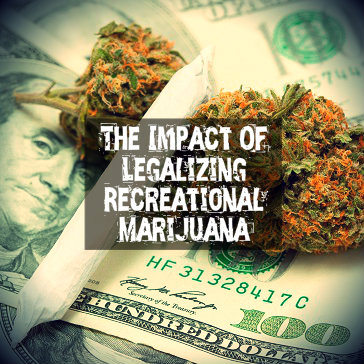 The main reason for the separate laws is the taxes levied against recreational users. Though medicinal users pay less taxes, they also have to get a Colorado Medical Marijuana Registry identification card, otherwise known as a “red card,” which costs $90 to obtain and to renew. (The price will be lowered to $15 in February 2014.)
The main reason for the separate laws is the taxes levied against recreational users. Though medicinal users pay less taxes, they also have to get a Colorado Medical Marijuana Registry identification card, otherwise known as a “red card,” which costs $90 to obtain and to renew. (The price will be lowered to $15 in February 2014.)
Colorado law bans the consumption of marijuana in public places, driving under the influence and taking the drug out of state. The state has also made it easier to win convictions against drivers who caused accident or injury while under the influence of drugs. The legal age of use is 21.
Recreational users can legally grow and possess up to six plants, up to one ounce of cultivated marijuana while traveling, and give a gift of up to one ounce to those 21 and up. Medicinal users can grow six plants as well, can possess up to two ounces of cultivated marijuana and can also gift up to an ounce to others who are at least 21.
Legal Marijuana Possibly Bringing In Big Bucks
Those who are celebrating the new law are optimistic about the revenue that the retail stores will generate. Research conducted by ArcView Market Research, a company that tracks data from the marijuana industry, reported that medical marijuana generated $1.4 billion in 2013. The researchers predict that number to grow to $2.34 billion in 2014, thanks to the new laws in Colorado and those in Washington, which will have its own law legalizing marijuana that will go into effect later this year. State officials predict that marijuana sales will generate an estimated $67 million in annual tax revenue.
Legal Marijuana’s Impact On Future Abuse And Addiction
Whether Colorado residents are for or against the legalization of marijuana, the impact of legalization on abuse and addiction could be seen for years to come.
Read More About The Pros And Cons Of Legalizing Recreational Marijuana And What It May Do For The Economy Of Our Country And The Health Problems Of Users
13 Jan 2014
Demi Lovato’s Battle With Addiction And Mental Illness – How Her Candid Story Can Help Teens
Actress and singer Demi Lovato has made a name for herself starring in television shows like The X-Factor and Sonny With A Chance. However, recently the 21-year-old star has been promoting her new memoir, Staying Strong: 365 Days a Year. The book details the young celebrity’s battles with several mental health conditions, including a drug addiction, eating disorder and alcohol abuse.
Lovato’s Personal Struggles
In her memoir and through a series of interviews, Lovato revealed her disorders as well as her triumphs. They include the following:
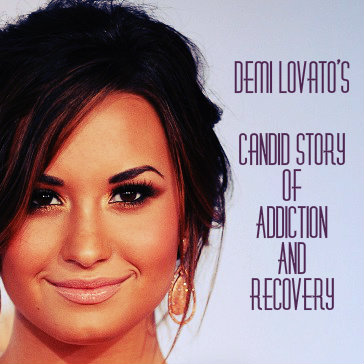 Drug addiction – The star has recounted how, during the peak of her addiction, she snorted cocaine practically every 30-60 minutes.
Drug addiction – The star has recounted how, during the peak of her addiction, she snorted cocaine practically every 30-60 minutes.- Alcohol abuse – Lovato reports that by age 19 her alcohol abuse was serious enough that she was drinking a soda bottle filled with vodka in the morning.
- Cutting – She’s spoken openly about her struggle with self-mutilation, which began at the tender age of 11. Lovato says she made cuts on her wrists to cope with negative emotions.
- Eating disorder – The young celebrity recalls how she first battled an eating disorder around age 12 or 13, although she began to worry about her body image earlier. This was triggered by becoming the target of bullies who cruelly labeled her as “fat.” Over the years, her self-destructive behaviors included compulsive overeating as well as anorexia and bulimia.
- Bipolar disorder – Lovato recounts how, initially, manic periods made her a productive songwriter. However, the cycles of mania and depression also made it painfully difficult for her to control her emotions.
By age 19, these conditions had taken a serious toll on Lovato’s well-being. She reports having a nervous breakdown during a concert tour. At one point, she reportedly physically struck one of her back-up dancers. That’s when her family and management team did the intervention that compelled her to quit the tour and enter into treatment. Lovato initially received three months of inpatient treatment, and then continued her treatment in an outpatient program. It was only after treatment started that she was diagnosed with bipolar disorder [1-5].
Co-Occurring Disorder – Not Unique
Mental health disorders often co-occur, creating havoc in the lives of young individuals and their families. While the scope of Lovato’s conditions may seem sensational – alcohol, drugs, cutting, depression, and mania – the reality is that some teen girls and young women deal with these challenging disorders on a daily basis.
Anorexia nervosa affects up to 3.5% of women during their lifetime, while bulimia afflicts approximately 4% of females. Over 85% of those with eating disorders report first experiencing symptoms before the age 20 [6]. Teens and young women may restrict eating habits or binge and purge for a variety of reasons, from the desire to have the “perfect” body to the need to conform to athletic standards. The impact of an eating disorder on physical and emotional health is profound. These conditions have the highest mortality rate of any mental health disorder. For example, 20% of individuals with anorexia will die early from complications such as suicide or heart problems [6].
Other psychiatric conditions, like those Lovato struggled with, also have a negative effect on adolescent girls and young women, too. Research reviews suggest that patients with bipolar disorder have higher rates of bulimia. The opposite is true as well, with bulimic patients showing elevated rates of bipolar disorder [7]. Likewise, researchers have connected eating disorders with self-injury behaviors, such as cutting. In one study, 40% of adolescents with an eating disorder engaged in some type of self-injury. Those who practiced binging and purging, in particular, were more likely to self-harm than those who restricted food intake [8].
It’s also common for young people with mental health conditions to wrestle with substance abuse, just as Lovato did. A teenager or young adult overwhelmed by negative emotions may turn to substances to self-medicate their symptoms. For instance, bipolar disorder so frequently co-occurs with drug or alcohol abuse that some experts suggest that all young people with the condition should be assessed for substance abuse [9].
Lovato’s Encouraging Turn-Around
Lovato says she’s been open about her struggles because she wants other young girls to know their lives don’t need to be destroyed by addiction and mental health issues. In addition to talking with media outlets and writing a book, Lovato has also become a contributing editor to Seventeen magazine, with a focus on addressing eating disorders and the pressure teen girls often feel to be perfect [10]. Earlier this year, she also joined the Substance Abuse and Mental Health Services Administration (SAMHSA) to promote National Children’s Mental Health Awareness Day.
The popular young star’s efforts may serve to increase awareness of these issues among teen girls and young women. For example, they may help remove some of the stigma linked to conditions like depression or bipolar disorder, making it a little easier for someone to admit she needs help. Lovato’s openness may also teach some to recognize potential mental health disorders, including substance abuse, in their friends.
Additionally, her story may spark conversation about how the drive for physical perfection affects young women. Mass media and social networks have the power to convey unrealistic expectations about appearance. For example, the recent “thigh gap” trend has raised concerns because it may be causing some teens and young women to engage in unhealthy eating behaviors. They strive to become thin enough to create a noticeable space between their upper thighs. Lovato’s struggles with her own body image and the serious impact it’s had on her well-being may help some young people re-examine how they feel about their own bodies.
Reaching Out For Mental Health And Addiction Help And Healing
If you are a young woman dealing with mental health challenges, such as depression or self-harm, or a substance abuse problem – of if you know someone who is – contact a treatment center. The staff will help you determine appropriate treatment options. In addition, you’ll learn more about the intervention process and how it works to guide a person into treatment. Reach out for help today.
Read More About News In Celebrity Addiction
Resources:
[1] http://www.accesshollywood.com/demi-lovato-reveals-i-would-smuggle-cocaine-on-planes-exclusive_article_87694?l=OrMCe04Lcp0lOAfwFxnxvTU9tcbLHGqa8dh4YNgqILhpcs3rrYzNyvjFFpL2UWFdmIyLovYOHoUw9OHNN-yfr-hT3QzJwxXaiY0E6jGOmKBd9kI-phnp10szTd5p31H3oLl4-d20JIUZB21TTGT0B8HYTWG85jaN3LpDOgDuYyeE_Ucklv4NTCPit-xOC3I
[2] http://www.foxnews.com/entertainment/2013/12/10/demi-lovato-couldnt-go-without-cocaine-for-30-minutes-to-hour/
[3] http://abcnews.go.com/Entertainment/demi-lovato-interview-teen-star-opens-bulimia-cutting/story?id=13405090
[4] http://www.people.com/people/article/0,,20483380,00.html
[5] http://www.cnn.com/2011/SHOWBIZ/celebrity.news.gossip/01/28/demi.lovato.treatment/index.html
[6] http://www.anad.org/get-information/about-eating-disorders/eating-disorders-statistics/
[7] http://www.ncbi.nlm.nih.gov/pubmed/15935230
[8] http://www.sciencedirect.com/science/article/pii/S1054139X10003095
[9] http://psychcentral.com/lib/substance-abuse-and-bipolar-disorder/0001033
[10] http://www.seventeen.com/health/tips/demi-lovato-hub
Substance use is common in a substantial minority of high school-age children across the U.S. Significant numbers of high school-age children also discontinue their education, or drop out, before receiving a diploma and never complete an alternative GED program. In 2013, officials from the federal Substance Abuse and Mental Health Services Administration released a report that examined the connection between dropping out of high school and the risks for involvement in substance use. Information for this report came from nine years of data gathered from a project called the National Survey on Drug Use and Health.
Dropout Rates
The U.S. Department of Education tracks high school dropout rates in a couple of ways. One method involves counting the percentage of people between the ages of 16 and 24 who do not attend high school and don’t possess a high school diploma, a GED certificate or any other certificate from a recognized, alternative educational program. In 2011, the last year for which full figures are available, 7 percent of individuals in the target age range who were not institutionalized or incarcerated fit this definition. High school dropout rates can also be roughly calculated by seeing how many incoming freshman go on to receive a diploma within a standard four-year timeframe. Three out of every four students successfully graduate on time, while the remaining 25 percent do not. Apart from any substance-related issues, common consequences of dropping out of high school include making less money, not receiving health insurance coverage and having increased risks for poverty and serious health issues.
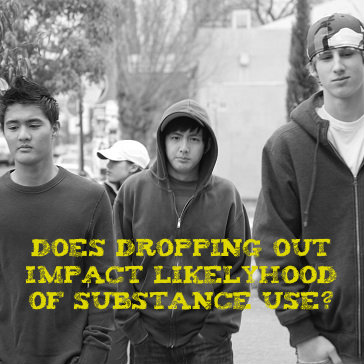 Teen Substance Use Rates
Teen Substance Use Rates
The National Institute on Drug Abuse regularly tracks trends for substance intake in U.S. 8th graders, 10th graders and 12th graders. With the exception of involvement with inhalants, older teenagers consistently engage in substance use more often than younger teens. For example, in 2012 over 40 percent of 12th graders drank alcohol in an average month, while only 27.6 percent of 10th graders drank as frequently. Similarly, while almost 23 percent of all 12th graders used marijuana on a monthly basis, only 17 percent of 10th graders used the drug as frequently. Percentages of monthly alcohol and marijuana use were even lower in 8th graders. Marijuana ranks as the most common drug choice among all high school students.
How Dropping Out Influences Substance Use Rates
In the report published by the Substance Abuse and Mental Health Services Administration, researchers used data gathered from the National Survey on Drug Use and Health between 2002 and 2010 to identify high school-age children who had dropped out by the 12th grade and determine how dropping out influences substance use rates. The survey’s results indicate that 13.2 percent of teens old enough to be in the 12th grade failed to graduate in this nine-year timespan. The dropout rate among boys was 14.7 percent, while the rate among girls was 11.6 percent. The ethnic groups most likely to drop out before or during the 12th grade were Native Americans/Alaskan Natives and Hispanics. Asian Americans and whites had the lowest dropout rates.
When compared to 12th graders who stayed in high school, dropouts of the same age had consistently higher monthly rates for all forms of substance use. For example, while only 22.4 percent of all enrolled 12th graders smoked cigarettes, 56.8 percent of all dropouts the same age smoked. While 35.3 percent of enrolled 12th graders drank alcohol, 41.6 percent of all dropouts the same age drank. Twelfth grade-age dropouts also had a higher rate of participation in a form of dangerous, short-term alcohol consumption called binge drinking. In addition, while 18.2 percent of all enrolled 12th graders used marijuana or some other illegal or illicit drug, 31.4 percent of all dropouts the same age used an illicit/illegal drug.
When compared to their gender, peers who remained in school, both 12th grade-age dropout boys and 12th grade-age dropout girls had significantly higher rates of intake for all commonly used substances. White 12th grade-age dropouts also had higher rates of intake for all substances than white 12th graders enrolled in school. The same pattern held true for African-American 12th grade-age dropouts and African-American 12th graders still attending school. Hispanics also largely followed the same pattern; however, the alcohol use rate was slightly higher among 12th grade Hispanics still enrolled in school than among Hispanic dropouts the same age. The two groups also had almost equal rates for participation in prescription drug abuse.
Importance Of Substance Abuse Prevention
The findings published by the Substance Abuse and Mental Health Services Administration clearly indicate that people who drop out of high school have substantially higher chances of becoming involved in substance use than their peers who remain in school. In the future, public health officials can use this information to place special emphasis on substance abuse prevention efforts aimed at teenagers and young adults who did not graduate from high school.
Read More About Teen Substance Abuse
Studies show that marijuana is being produced today is over 10 percent more potent than it was 30 years ago, and some producers have created the strongest strains ever recorded.
A lab at the University of Mississippi that tracks potency in marijuana seized by federal law enforcers reported finding strains with 37 percent potency. In 1972, the average potency was less than one percent. Dr. Mahmoud ElSohly, director of the Ole Miss studies, says the danger is not the marijuana itself, but that young users don’t know what they’re smoking is so potent.
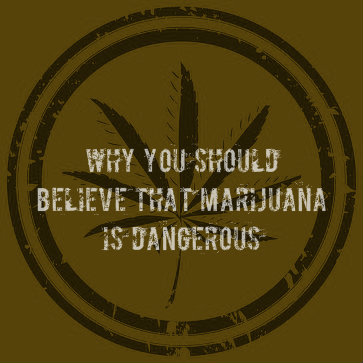 Dangerous Side Effects Of Marijuana
Dangerous Side Effects Of Marijuana
The National Institute on Drug Abuse (NIDA) says that high levels of THC, the ingredient in marijuana that causes psychoactive effects, could lead to a drop in IQ for those who smoke at a young age.
It is the altered state of mind which causes disorientation, anxiousness and poor decision making that’s the most dangerous side effect of smoking marijuana. When people smoke highly potent strains they may not be prepared for the side effects and consequences.
It’s not the age at which young adults start using, it’s the perception that marijuana isn’t dangerous.
Many Teens Are Smoking Marijuana And Are Not Properly Educated Of The Harm
According to the NIDA survey “Monitoring the Future,” over one-third of seniors admitted to smoking marijuana in the preceding 12 months. The number of middle school-aged children who admit to marijuana use has tripled from 1993. More astonishingly, 60 percent of high school seniors report not seeing regular marijuana use as harmful.
On top of being uneducated about the harmful consequences of smoking marijuana, users are also putting unknown chemicals into their bodies. Marijuana producers are always creating different strains and mixing the drug with other ingredients, causing unknown side effects. So there is no way for people who don’t know what they are smoking to anticipate the strong effects the drug will have on them. This takes even more control away from users and creates dangerous situations, like increased changes of intoxicated driving.
Read More: Is Marijuana Really Addictive?
25 Dec 2013
Stopping The Flow Of Dangerous Synthetic Drugs
The chemical make-up of synthetic drugs are in a continuous state of flux, means their effects aren’t predictable and correct emergency treatment can be difficult. Those in law enforcement are often handcuffed in terms of prosecution because these substances can be modified to slip through current drug laws. Now there’s a group that’s trying to tighten the net.
The National Alliance for Model State Drug Laws (NAMSDL) want to stop the proliferation of synthetic drugs, which are the second most commonly used illicit drug among young people, according to a 2012 Monitoring the Future survey. One out of every nine high school seniors reported having used synthetic drugs within the past year.
How And Why The Recipes Of Synthetic Drugs Keeps Changing
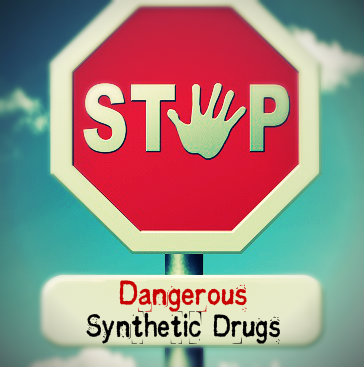 Synthetic drugs can be either man-made marijuana (cannabinoids) or chemicals related to amphetamines (cathinones). The synthetic marijuana, often sold under the names K2 or Spice, are plant materials resembling potpourri that are sprayed with chemicals that mimic THC, the psychoactive agent in marijuana. But the recipe keeps changing in order to evade prosecution.
Synthetic drugs can be either man-made marijuana (cannabinoids) or chemicals related to amphetamines (cathinones). The synthetic marijuana, often sold under the names K2 or Spice, are plant materials resembling potpourri that are sprayed with chemicals that mimic THC, the psychoactive agent in marijuana. But the recipe keeps changing in order to evade prosecution.
In 2012 the federal government made synthetic drugs, also known as novel psychoactive drugs, illegal. But the law defines the drugs narrowly. Once those who make the drugs tweak the recipe, the new compound no longer fits within the narrow definition of synthetic drugs. To further complicate the matter, the substances are often sold as bath salts, incense or plant food with a label saying they’re not intended for human consumption.
How The Spread Of Synthetic Drugs Is Trying To Be Halted
What NAMSDL wants to do is work with state lawmakers to make classes of substances illegal, rather than specific chemical combinations. The laws could give examples of what some of those substances might look like, but would leave room so that potential new chemical compounds would be illegal. That would certainly speed things up for law enforcement that now must often wait a year and a half before each new synthetic drug compound is banned.
NAMSDL also wants to enhance communication between those who see the changing drug landscape firsthand. The Drug Enforcement Agency currently collects and disseminates drug information to concerned parties, but it’s hospital emergency rooms, poison control centers and law enforcement that sees what’s going on in real time. This would help keep the information on synthetic substances truly up-to-date
Synthetic Drug Education And Prevention
NAMSDL is working directly with the Office of National Drug Control Policy and others to create an effective education and prevention campaign aimed at informing moms, dads, emergency room staff and school administrators about what these drugs are and what they do. Education, information flow and improved legislation represent a 360 degree effort on closing the gaps and halting the flow of these dangerous drugs.
Read More About Synthetic Drugs Causing More Emergency Room Visits Than Real Drugs
23 Dec 2013
Is Marijuana Really Addictive?
Many people take marijuana use with a grain of salt. It’s not a hard drug, right? It’s legal in two states now, so how bad could it be for you? If you have a loved one, maybe a teenager, who is smoking pot, you may wonder if he is at risk of becoming addicted. You should be worried, but not for the reasons you might think.
Marijuana Addiction
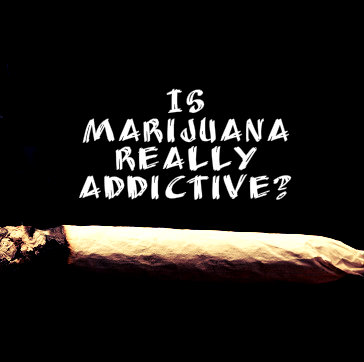 Most people who use marijuana do so recreationally and without developing an addiction. When compared to other drugs that are highly addictive, like heroin, meth or cocaine, marijuana seems very innocent. Those harder drugs can result in dependence in a user very quickly. What makes some drugs so addictive is that the body becomes physically dependent upon them. A heroin addict needs another hit just to feel normal again, to stop the pain, the anxiety, the irritability and the shaking that come with withdrawal.
Most people who use marijuana do so recreationally and without developing an addiction. When compared to other drugs that are highly addictive, like heroin, meth or cocaine, marijuana seems very innocent. Those harder drugs can result in dependence in a user very quickly. What makes some drugs so addictive is that the body becomes physically dependent upon them. A heroin addict needs another hit just to feel normal again, to stop the pain, the anxiety, the irritability and the shaking that come with withdrawal.
Marijuana does produce some light withdrawal symptoms. A regular user might start to feel a little irritable and experience an elevated heart rate when he has stopped using for a day or two. These symptoms are much milder than those seen with harder drugs, though. So is marijuana addictive? The answer is yes. Addiction is more complicated than physical dependence.
It is possible that your teen will become addicted to marijuana if he uses it regularly and frequently. If he begins to smoke pot in a way that is compulsive, if he can’t seem to stop, he needs it to relax, or he needs it to get going in the morning and to sleep at night, these are all signs of an addiction, whether he is physically dependent on the drug or not.
Marijuana Risks
Even if your teen does not become addicted and sticks to casual, recreational use of marijuana, there are still risks. When he smokes pot, it makes his heart rate go up, it makes him disoriented, it makes him uncoordinated and it may make him anxious or paranoid. Marijuana is a mind-altering substance. If he tries to do anything while high, such as drive a car, or even just cross a street, he could cause an accident.
Smoking pot also carries many of the same risks as smoking cigarettes. Substances in the smoke can cause cancer and lung disease, especially with regular use. Long-term marijuana use has been shown to cause abnormalities in the brain and the development of psychiatric problems. Another problem with smoking pot is that it tends to make people lazy and apathetic. This is not true for everyone, but someone who is high all of the time is not likely to get much done.
Parents Talking With Their Teens About Marijuana Use And Its Risks
So although marijuana can in fact be addictive, it is important to remember that it is not in the same class as harder drugs. There are different ways to become addicted to a substance or a behavior. Addiction to marijuana is often more of a behavioral habit than a physical dependence.
Aside from addiction, there are many other reasons to be concerned if your teen is smoking pot. Sit your teen down for a talk about the dangers and risks associated with using this drug. Explain the possibility of addiction and the physical damage it can do to his body. With information, you empower your teen to make the best choices.
Read More About How Marijuana Use Is Linked To Mental Disorders


